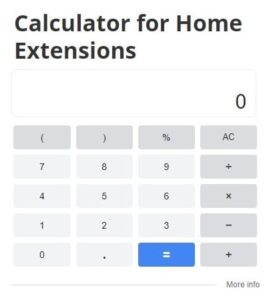
At Home Owners Association, we understand the importance of energy-efficient home improvements. These upgrades not only reduce your carbon footprint but can also lead to significant savings on your energy bills.
What many homeowners don’t realize is that they can benefit from energy-efficient home improvements tax credits. This guide will walk you through the available credits, eligible improvements, and how to claim them effectively.
What Are Energy-Efficient Home Improvements Tax Credits?
Understanding Energy-Efficient Upgrades
Energy-efficient home improvements reduce energy consumption and lower utility bills. These upgrades include solar panel installations, insulation enhancements, and more efficient heating and cooling systems. Across Australia, homeowners implement these changes to create more sustainable living spaces.
Australian Government Incentives
The Australian government offers tax credits to make eco-friendly home upgrades more affordable. These credits directly reduce your tax liability, providing a financial incentive for environmentally conscious improvements. The Small-scale Renewable Energy Scheme (SRES) stands out as a key program, offering financial support for eligible solar panel systems, solar water heaters, and heat pumps.
Small-scale Technology Certificates (STCs)
STCs form the backbone of the SRES incentive structure. When you install eligible systems, you create these certificates, which you can then sell to offset your costs. The number of STCs you receive varies based on how much electricity they generate or displace.
Solar Credits Program
As part of the SRES, the Solar Credits program amplifies the benefits for solar panel installations. This initiative multiplies the number of STCs for the first 1.5 kilowatts of capacity in eligible systems. The result? Homeowners often see a significant reduction in their initial installation costs.
Eligibility Requirements
To qualify for these tax credits, you must meet specific criteria:
- You must own and occupy the property where the improvements take place (rental properties may qualify under different rules).
- All improvements must be new and comply with Australian standards.
- For solar panel systems, the capacity must not exceed 100 kilowatts.
- Installation must be carried out by a Clean Energy Council accredited professional.
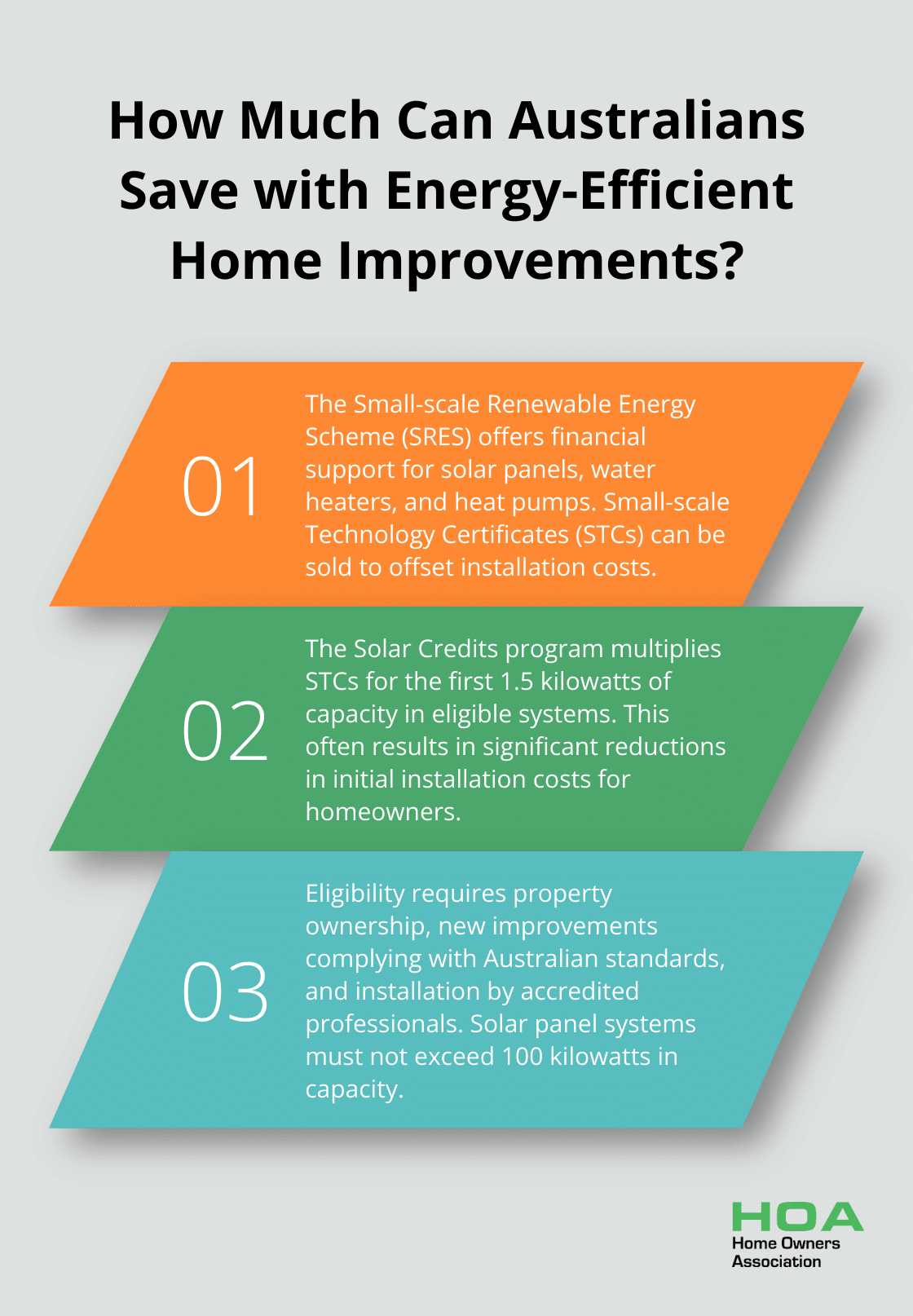
It’s important to note that eligibility can differ by state and territory. For example, Victoria offers additional rebates through its Solar Homes Program, while South Australia provides a Home Battery Scheme.
Maximizing Your Benefits
To optimize your tax credit benefits, consider these strategies:
- Act quickly: The value of STCs decreases annually, so earlier installation leads to greater savings.
- Combine incentives: Leverage both federal and state-specific programs to maximize your cost reductions.
- Keep thorough records: Maintain all receipts and documentation related to your improvements for claiming your credits.
With these energy-efficient home improvements tax credits, Australian homeowners have a unique opportunity to upgrade their properties while reducing their environmental impact. As we explore the specific types of eligible improvements in the next section, you’ll discover how these credits can apply to a wide range of home upgrades.
What Home Improvements Qualify for Energy Tax Credits?
Solar Panel Installations: Power from the Sun
Solar panels top the list for energy-conscious homeowners. Installing an eligible system allows the creation of small-scale technology certificates (STCs) with a value that can be redeemed by selling or assigning them. The Small-scale Renewable Energy Scheme (SRES) offers substantial incentives for these systems. The value of STCs decreases annually, so earlier installation leads to greater savings.
Windows and Doors: Efficiency Sealed In
Energy-efficient windows and doors significantly reduce heat transfer, leading to lower heating and cooling costs. While these improvements don’t directly qualify for federal tax credits, state-specific rebates often apply. The Victorian Energy Upgrades program, for instance, offers discounts on double-glazed windows (which can cut heat loss by up to 30% compared to single-pane alternatives).
High-Efficiency HVAC Systems: Year-Round Comfort
Energy-efficient heating and cooling systems lead to substantial energy savings. Heat pumps, in particular, qualify for STCs under the SRES. Individuals or businesses can earn STCs when they install eligible small-scale renewable energy systems. Your location and the system’s capacity determine the number of STCs you’ll receive, but it can significantly offset initial costs.
Insulation: The Unseen Energy Saver
Insulation upgrades don’t directly qualify for federal tax credits, but they maximize the efficiency of other energy-saving improvements. Many state governments offer rebates for insulation upgrades. The ACT Government’s Home Energy Support Program provides up to $2,500 for ceiling insulation upgrades (for eligible households). Proper insulation can reduce your energy bills by up to 45%, according to the Department of Industry, Science, Energy and Resources.
Roofing: More Than Just Cover
Energy-efficient roofing materials, such as cool roofs with high solar reflectance, can significantly reduce your home’s cooling needs. While these don’t qualify for federal tax credits, local council rebates often apply. Some councils offer up to $500 for cool roof installations, recognizing their potential to reduce urban heat island effects and energy consumption.
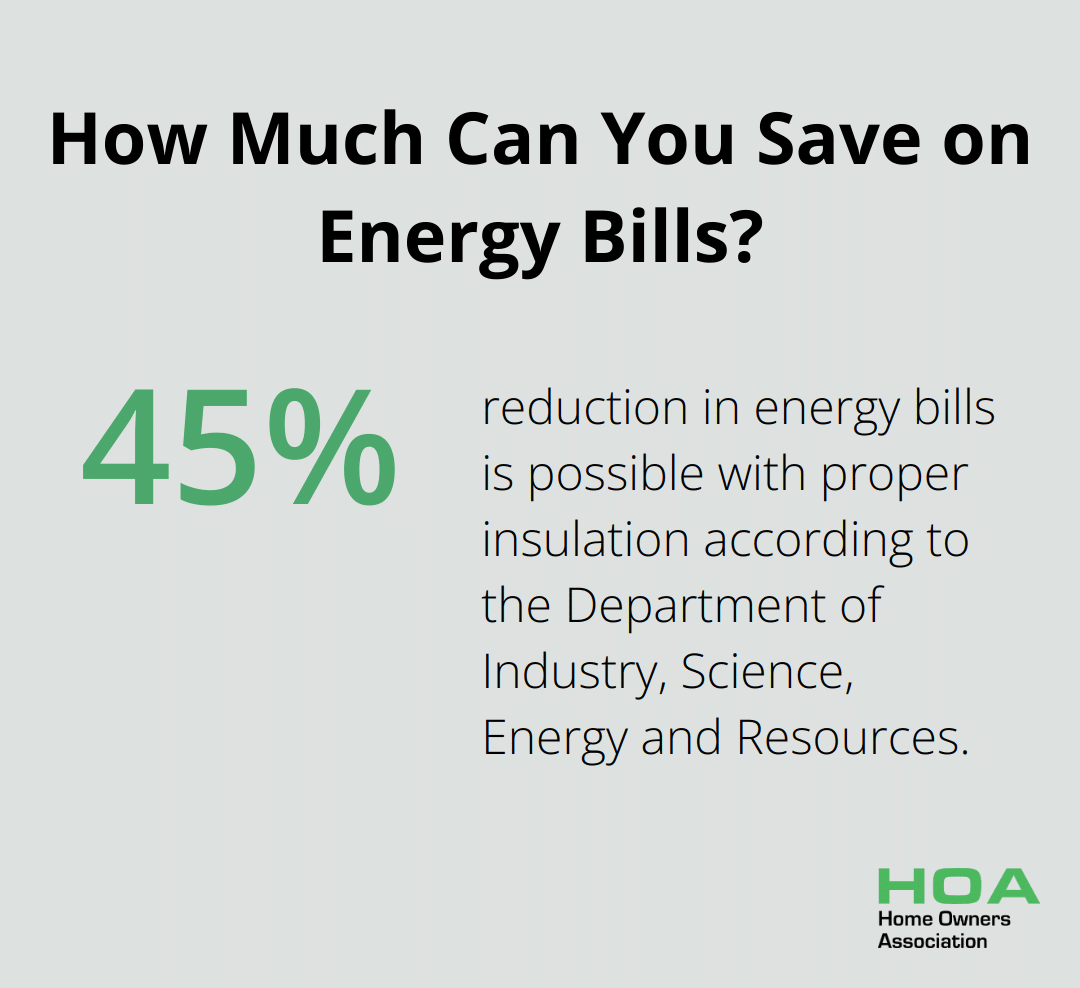
Combining multiple improvements often yields the best results, both in terms of energy savings and tax benefits. As we move forward, let’s explore how to claim these valuable energy-efficient home improvement tax credits effectively.
How to Claim Energy-Efficient Home Improvement Tax Credits
Collect Essential Documentation
The first step to claim your tax credits is to gather all necessary paperwork. This includes:
- Receipts for purchases and installations
- Certificates of compliance for products
- Documentation provided by your installer
- Certificate of STCs (Small-scale Technology Certificates) for solar panel systems
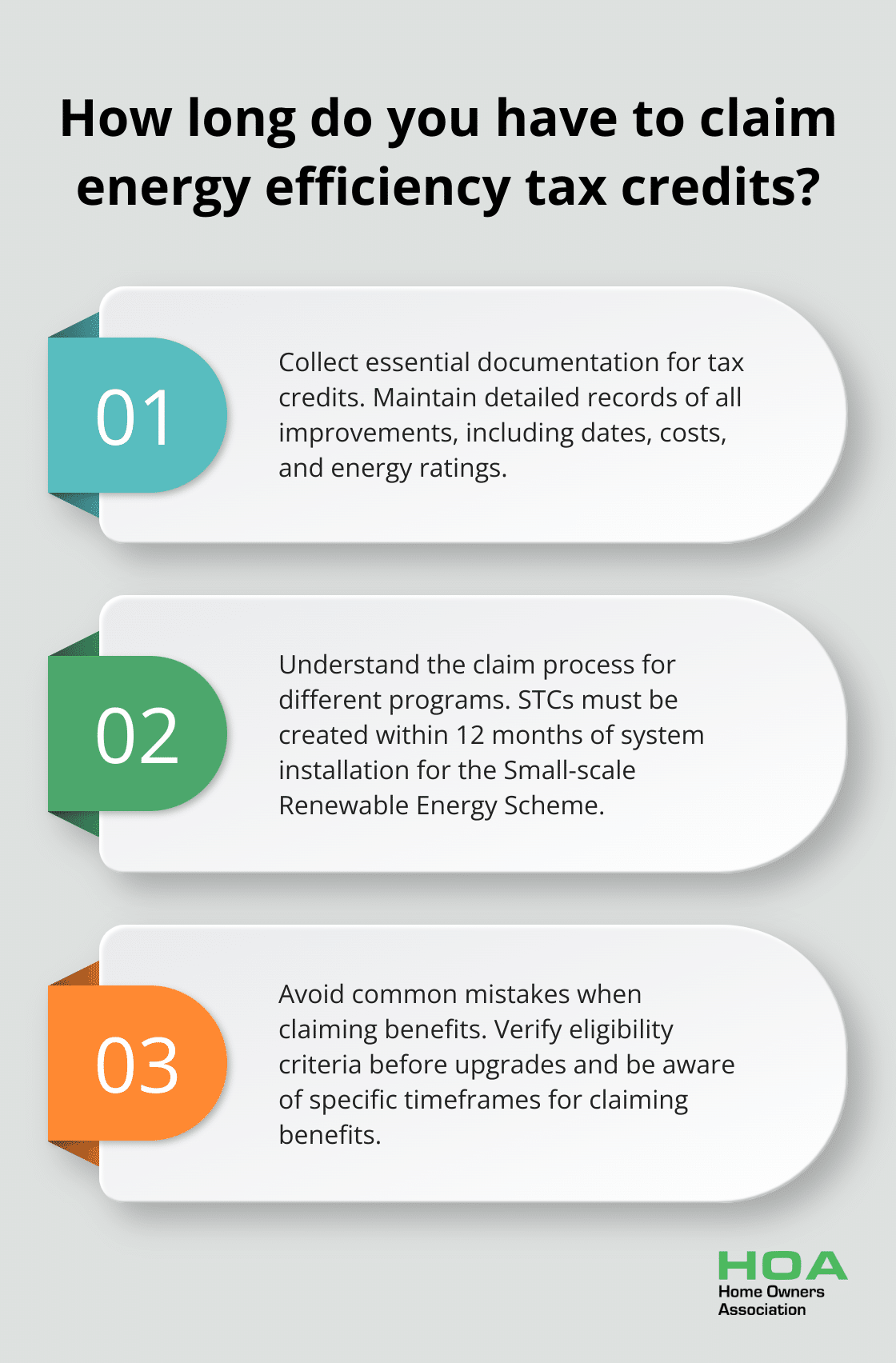
Maintain a detailed record of all improvements, including dates, costs, and energy ratings of products. This information is essential when you fill out your tax return or apply for rebates.
Understand the Claim Process
The process to claim energy-efficient home improvement tax credits differs based on the specific program:
-
Small-scale Renewable Energy Scheme (SRES): Most people assign the right to create STCs to a registered agent in exchange for an upfront discount on the system’s purchase price.
-
State-specific rebates: You often need to apply through the relevant government department’s website. For example, the Victorian Energy Upgrades program requires you to use an accredited provider who will apply the discount at the point of sale.
-
Rental property tax deductions: Include these on your annual tax return. The Australian Taxation Office provides specific guidance on how to claim these deductions.
Sidestep Common Mistakes
To maximize your benefits, avoid these frequent errors:
-
Neglecting eligibility criteria: Always verify that your planned upgrades qualify for credits or rebates before you proceed.
-
Missing deadlines: Many programs have specific timeframes for claiming benefits. For instance, you must create STCs within 12 months of installing your system.
-
Overlooking tax implications: Factor in the impact of rebates on your tax situation. In some cases, receiving a rebate may reduce the cost base of your property for capital gains tax purposes.
Seek Professional Assistance
If you find the process complex, consider seeking help from a tax professional or energy efficiency expert. The Energy Efficiency Council has released a tax incentives guide that considers how tax incentives can be leveraged to drive energy performance improvements.
Stay Informed About Program Changes
Tax credit programs and rebates can change over time. Stay updated on the latest information from government sources and industry associations. This knowledge will help you make informed decisions about future energy-efficient improvements and maximize your potential savings.
Final Thoughts
Energy-efficient home improvements offer numerous benefits for Australian homeowners. These upgrades reduce energy bills, increase property value, and contribute to a greener future. The energy-efficient home improvements tax credit makes these upgrades even more attractive, providing financial incentives that can significantly offset initial costs.
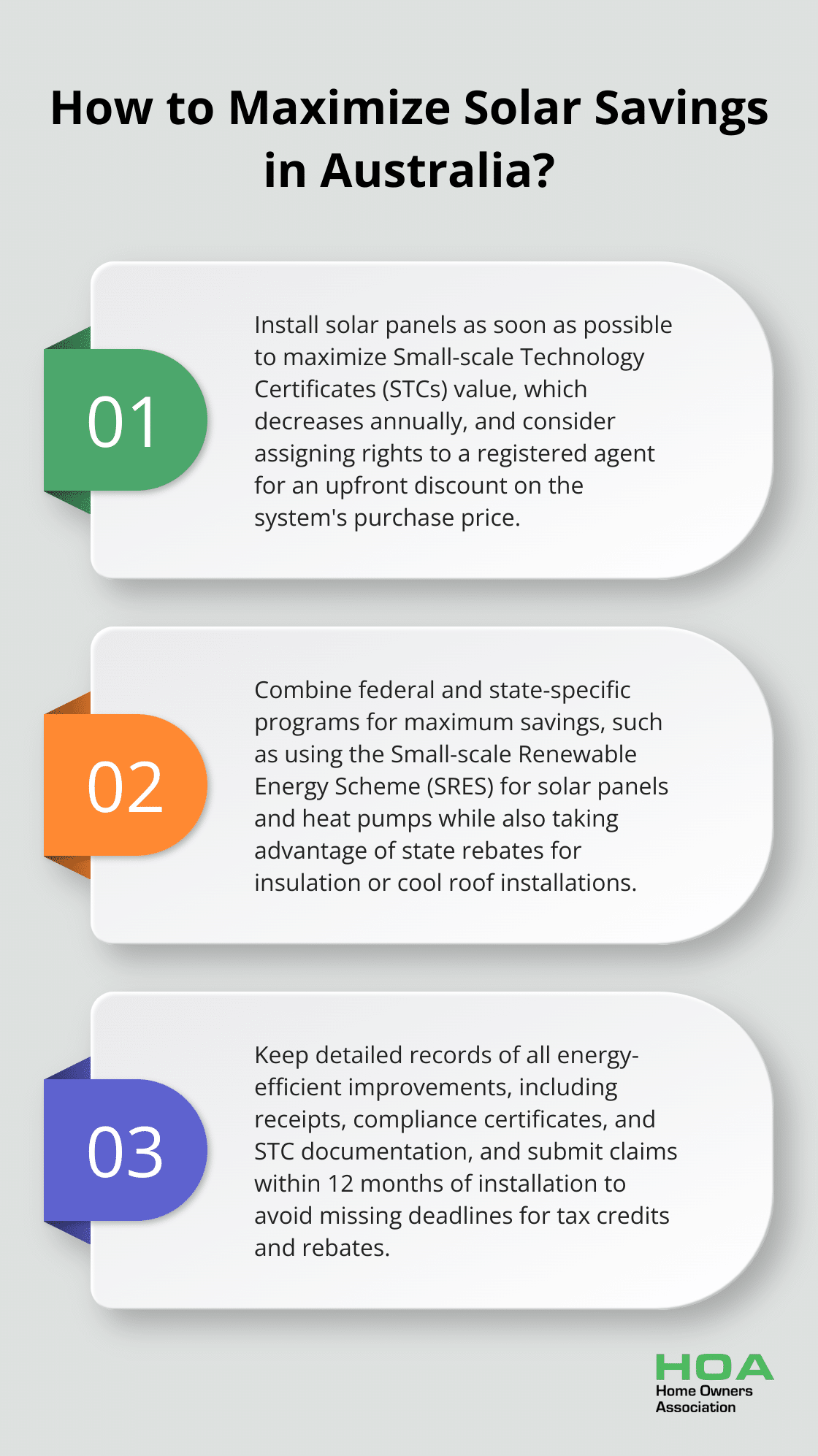
We at Home Owners Association encourage Melbourne homeowners to plan their energy-efficient upgrades. Our exclusive benefits include trade pricing and discounts on construction and renovation materials (which can help maximize your savings). Our expert advice and personalized guidance ensure that your projects meet high standards of quality and efficiency.
The sooner you act, the more you stand to gain. With decreasing values for Small-scale Technology Certificates and evolving rebate programs, now is the ideal time to start your energy efficiency journey. Take the first step towards a more energy-efficient home today and explore the available tax credits.





